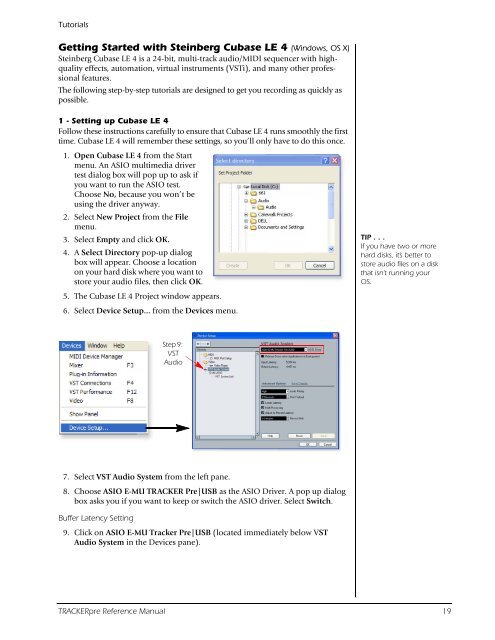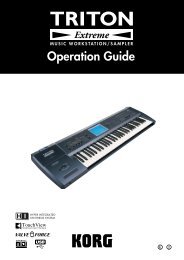Audio Interface / Mobile Preamp - zZounds.com
Audio Interface / Mobile Preamp - zZounds.com
Audio Interface / Mobile Preamp - zZounds.com
You also want an ePaper? Increase the reach of your titles
YUMPU automatically turns print PDFs into web optimized ePapers that Google loves.
Tutorials<br />
Getting Started with Steinberg Cubase LE 4 (Windows, OS X)<br />
Steinberg Cubase LE 4 is a 24-bit, multi-track audio/MIDI sequencer with highquality<br />
effects, automation, virtual instruments (VSTi), and many other professional<br />
features.<br />
The following step-by-step tutorials are designed to get you recording as quickly as<br />
possible.<br />
1 - Setting up Cubase LE 4<br />
Follow these instructions carefully to ensure that Cubase LE 4 runs smoothly the first<br />
time. Cubase LE 4 will remember these settings, so you’ll only have to do this once.<br />
1. Open Cubase LE 4 from the Start<br />
menu. An ASIO multimedia driver<br />
test dialog box will pop up to ask if<br />
you want to run the ASIO test.<br />
Choose No, because you won’t be<br />
using the driver anyway.<br />
2. Select New Project from the File<br />
menu.<br />
3. Select Empty and click OK.<br />
4. A Select Directory pop-up dialog<br />
box will appear. Choose a location<br />
on your hard disk where you want to<br />
store your audio files, then click OK.<br />
5. The Cubase LE 4 Project window appears.<br />
6. Select Device Setup… from the Devices menu.<br />
Step 9:<br />
VST<br />
<strong>Audio</strong><br />
7. Select VST <strong>Audio</strong> System from the left pane.<br />
8. Choose ASIO E-MU TRACKER Pre|USB as the ASIO Driver. A pop up dialog<br />
box asks you if you want to keep or switch the ASIO driver. Select Switch.<br />
Buffer Latency Setting<br />
9. Click on ASIO E-MU Tracker Pre|USB (located immediately below VST<br />
<strong>Audio</strong> System in the Devices pane).<br />
TIP . . .<br />
If you have two or more<br />
hard disks, it’s better to<br />
store audio files on a disk<br />
that isn’t running your<br />
OS.<br />
TRACKERpre Reference Manual 19

















